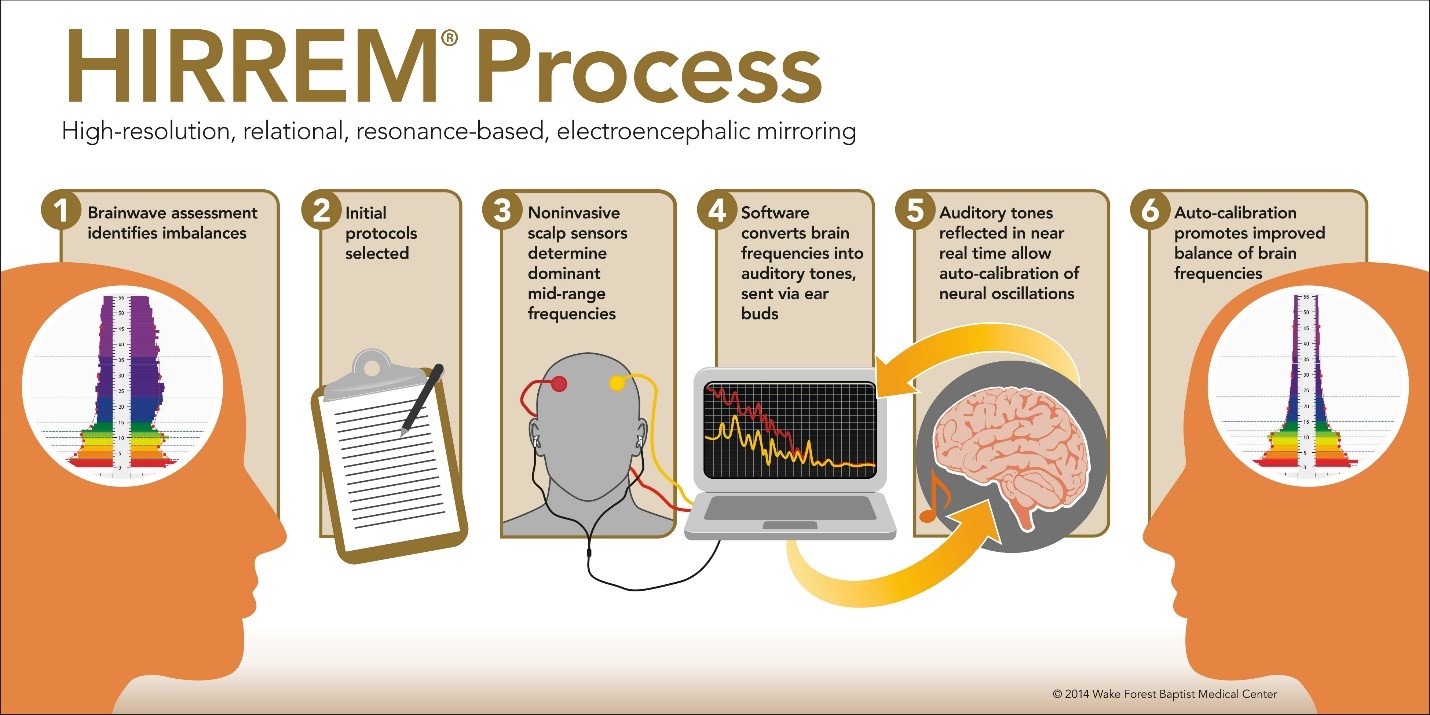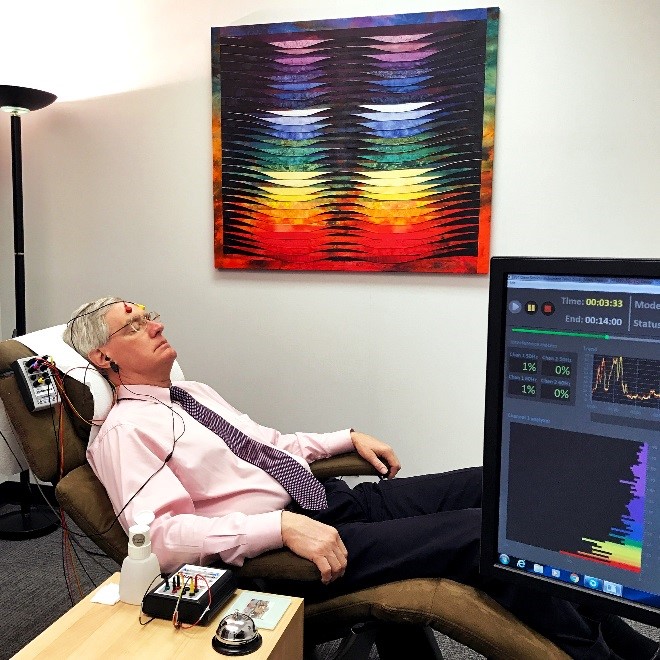In 2011, the Brain Body Research Program launched a series of research projects to evaluate the use of HIRREM® in a clinical setting. The primary goals were to evaluate the potential benefits of HIRREM, identify which symptoms or conditions may benefit and define the magnitude of any benefit using accepted scientific methods. With the help of many collaborators our secondary goal was to better understand the mechanism(s) of action for HIRREM. In early 2020, our team wrapped up research studies using HIRREM since the core technology was updated and rebranded to Cereset Research.
What is HIRREM?
![]() High-resolution, relational, resonance-based, electroencephalic mirroring® (HIRREM, Brain State Technologies, Scottsdale, AZ) is a noninvasive, closed-loop, acoustic stimulation neurotechnology. Scalp sensors monitor brainwaves, and software algorithms translate specific frequencies into audible tones of varying pitch in real time. These are immediately mirrored back via ear buds, allowing the brain a chance to listen to itself, or to “look at itself” in an acoustic mirror. Such rapid updating regarding its own pattern, and resonance between the acoustic stimulation (tones) and oscillating brain networks supports the brain to auto-calibrate, to self-adjust, to relax, and to re-set what have become stuck stress response pattern, as with a musical instrument tuning itself. The brain pattern is typically observed to shift towards improved balance and often reduced hyperarousal, with no conscious, cognitive activity required.
High-resolution, relational, resonance-based, electroencephalic mirroring® (HIRREM, Brain State Technologies, Scottsdale, AZ) is a noninvasive, closed-loop, acoustic stimulation neurotechnology. Scalp sensors monitor brainwaves, and software algorithms translate specific frequencies into audible tones of varying pitch in real time. These are immediately mirrored back via ear buds, allowing the brain a chance to listen to itself, or to “look at itself” in an acoustic mirror. Such rapid updating regarding its own pattern, and resonance between the acoustic stimulation (tones) and oscillating brain networks supports the brain to auto-calibrate, to self-adjust, to relax, and to re-set what have become stuck stress response pattern, as with a musical instrument tuning itself. The brain pattern is typically observed to shift towards improved balance and often reduced hyperarousal, with no conscious, cognitive activity required.
HIRREM Process
The brain is the organ of central command that controls the body’s response to trauma or threat, whether the trauma is physical or non-physical. This unique organ manages the survival (stress) responses that are facilitated by the autonomic nervous system including the sympathetic (fight or flight), or parasympathetic (freeze or withdraw) state. The brain also has plasticity, meaning that it can change and adapt its pattern of function to meet anticipated needs. Repetitive or cumulative trauma, or a severe event, might result in persisting activation of an autonomic response, i.e. sympathetic dominant physiological state, or overall hyperarousal of the autonomic nervous system. These physiological changes can result in symptoms such as insomnia or anxiety. If these stress responses become chronic, they may contribute to disease states such as hypertension.

High-resolution, relational, resonance-based, electroencephalic mirroring (HIRREM®), developed and licensed by Brain State Technologies, LLC, Scottsdale, AZ, is a noninvasive, closed-loop, allostatic, acoustic stimulation neurotechnology. Scalp sensors monitor brainwaves, and computer software identifies specific frequencies, which are mirrored back in real time as audible tones of varying pitch and timing (Gerdes L, et al., Brain Behav, 2013). This supports the brain to auto-calibrate, to self-adjust, to relax. The brain pattern is typically observed to shift towards improved balance and reduced hyperarousal, with no conscious, cognitive activity required from the recipient.
 The HIRREM intervention was administered as a series of in-office sessions with the recipient sitting or reclining in a comfortable chair. A session was made up of a number of protocols addressing different scalp/brain locations, some done with eyes open, some with eyes closed. The number and length of sessions varied between specific research studies, but the goal is to complete sessions within 2-3 weeks. Integration of changes, and accompanying shifts in symptoms can continue to occur for weeks or months after completion of HIRREM sessions. Because they might interfere with the HIRREM process, or negate changes made during a course of HIRREM sessions, alcohol, and other recreational drugs were recommended to be avoided during and for at least 4 weeks after completion of HIRREM sessions. HIRREM is not a medical device and is not intended to treat, cure, heal, or diagnose any disease, mental illness or symptom, and individual results and duration of effects may vary.
The HIRREM intervention was administered as a series of in-office sessions with the recipient sitting or reclining in a comfortable chair. A session was made up of a number of protocols addressing different scalp/brain locations, some done with eyes open, some with eyes closed. The number and length of sessions varied between specific research studies, but the goal is to complete sessions within 2-3 weeks. Integration of changes, and accompanying shifts in symptoms can continue to occur for weeks or months after completion of HIRREM sessions. Because they might interfere with the HIRREM process, or negate changes made during a course of HIRREM sessions, alcohol, and other recreational drugs were recommended to be avoided during and for at least 4 weeks after completion of HIRREM sessions. HIRREM is not a medical device and is not intended to treat, cure, heal, or diagnose any disease, mental illness or symptom, and individual results and duration of effects may vary.
542 participants enrolled in clinical studies that evaluated HIRREM. The use of HIRREM in these studies was associated with reduced symptoms including insomnia, depressive mood, stress, and anxiety, as well as improved autonomic function manifested by improved measures of heart rate variability and baroreflex sensitivity. There was also improved network connectivity on whole brain rest MRI scans in a cohort with symptoms of military-related traumatic stress.
